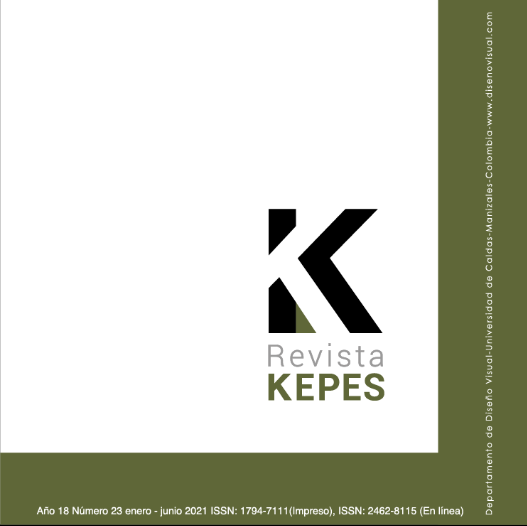Authors
Abstract
This article presents the results of a research project whose general objective was to reflect on the characteristics of amateur audiovisual creation in the digital era from the review of variations and continuities over time regarding non-professional production practices. with other devices such as photography and cinema. The following lines focus on a round trip to the past and the present that, through dialectical interpretation, allows establishing comparisons between characteristics of the development of amateur cinema and amateur audiovisual production that circulates on the Internet or homecasting. Based on the documentary review and framed in postulates from cultural history, visual studies, cultural studies and the sociology of technology, it is concluded that in the current panorama of audiovisual production, this comparison between amateur cinema and homecasting, beyond pointing out some specific elements, it contributes to the necessary multidisciplinary inquiry and the inclusion of vectors such as the historical-cultural vector, to understand, study and teach contemporary visualities in more critical and complex ways.
References
Askari, K. (2009). Early 16mm Colour by a Career Amateur. Film History, 21(2), 150–163. http://www.jstor.org/stable/40406020
Brea, J. L. (1991). Las auras frías. El culto a la obra de arte en la era postaurática. Barcelona: Editorial Anagrama.
Brea, J. L. (2007). Cultura RAM: Mutaciones de la cultura en la era de su distribución electrónica. Madrid: Gedisa Editorial.
García Varas, A. (2011). Filosofía de la imagen. Salamanca: Ediciones Universidad de Salamanca.
Gómez Cruz, E. (2007). De la cultura Kodak a la imagen en Red. Barcelona: UOC Press.
Gómez Mantecón, A. (2012). El cine super 8 en México (1970-1989). México: UNAM, Filmoteca.
Girona, R. (2015). El Cine de propaganda en EE. UU. Barcelona: Editorial UOC.
Groys, B. (2016). Volverse Publico. Las transformaciones del arte en el ágora contemporánea. Buenos Aires: Caja Negra Editora.
Gubern, R. (1969). Historia del Cine. Barcelona: Editorial Anagrama.
Habermas, J. (1986). Ciencia y Tecnología como ideología. Madrid: Letra e.
Jay, M. (1988). Scopic regimes of modernity. In Foster, H. (Ed.), Vision and visuality (pp. 3-28). Seattle: Bay Press.
Jenkins, H. (2008). Convergence Culture. La cultura de la convergencia de los medios de comunicación. Barcelona: Ediciones Paidós.
Manovich, L. (2006). El Lenguaje de los Nuevos Medios de Comunicación. La imagen en la Era Digital. Madrid: Paidós.
Manovich, L. (2014). Post-Media Aesthetics. In M. Kinder & T. McPherson (eds.), Transmedia Frictions. The Digital, the Arts, and the Humanities. Oakland: University of California Press.
Moreno Acosta, A. M. (2015). Homecasting: Ecos del pasado, dualidades del presente. Memorias del XXVII Encuentro Nacional Asociación Mexicana de Investigadores de la Comunicación AMIC 2015. Universidad Autónoma de Querétaro, México. https://www.academia.edu/22696676/Homecasting_Ecos_del_pasado_dualidades_del_presente
Moreno Acosta, A. M. (2016). Fotografía amateur: la construcción cultural de un rol. Revista Comunicación, 34(1), 23-38. https://revistas.upb.edu.co/index.php/comunicacion/article/view/6768
Moraza, J. L. (2012). El arte en la era del capitalismo cognitivo. Jornadas de El arte en la Sociedad del Conocimiento, organizadas por la Sección de Artes Plásticas y Monumentales de la Sociedad de Estudios Vascos. Facultad de Bellas Artes de la Universidad del País Vasco.
Mitchell, W. J. T. (1994). The Pictorial Turn. In Pictorial Theory: Essays on Verbal and Visual Representation (pp. 11-34). Chicago, University of Chicago Press.
Orell García, M. (2006). Las Fuentes del Nuevo Cine Latinoamericano. Valparaiso: Ediciones Universitarias Pontificia Universidad Católica de Valparaiso.
Prada, J. M. (2015). Practicas Artísticas e Internet en la Época de las Redes Sociales. Madrid: AKAL.
Punt, M. (2000). Parallel Histories: Early Cinema and Digital Media. Convergence: The International Journal Of Research Into New Media Technologies, 6(2), 62-76. https://doi.org/10.1177%2F135485650000600205
Sadoul, G. (2004). Historia del Cine Mundial. México: Siglo XXI Editores.
Swanson, D. (2003). Inventing amateur film: Marion Norris Gleason, Eastman Kodak and the Rochester scene, 1921-1932. Film History, 15, 126-136. http://www.jstor.org/stable/3815505
Szczelkun, S. (2000). The Value of Home Movies. Oral History, 28(2), 94–98. http://www.jstor.org/stable/40166863
Toffler, A. (1980). The Third Wave. New York: Bantam Books.
Van Dijck, J. (2007). Television 2.0: YouTube and the Emergence of Homecasting. University of Amsterdam, Media in Transition International Conference, MIT. Amsterdam.
Wesch, M. (2009). Users Like You: Theorizing Agency in User-Generated Content. Media, Culture And Society, 31(1), 41-58.
Williams, R. (2003). Retooling: A Historian Confronts Technological Change. Massachusetts: The MIT Press.
Zimmermann, P. R. (1988). Professional Results with Amateur Ease: The Formation of Amateur Filmmaking Aesthetics 1923-1940. Film History, 2(3), 267–281. https://www.jstor.org/stable/3815121

 PDF (Español)
PDF (Español)
 FLIP
FLIP






















